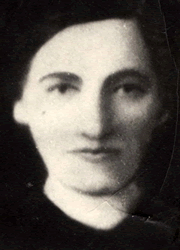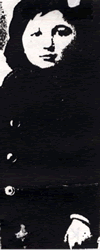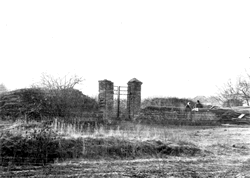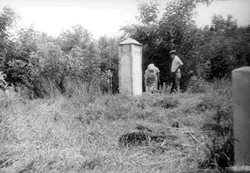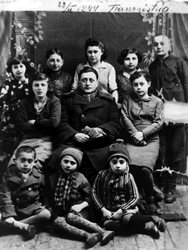Wechter Family
Click on Photos to Enlarge
#wctr-1:
#wctr-2:
#wctr-3
#wctr-4
#wctr-5
#wctr-6
#wctr-7
#wctr-8
#wctr-9
#wctr-10
#wctr-11
Sarah Secemski nee Wachter was born in Wolbrom, Poland in 1902 to Chaia and Shlomo Wachter. Prior to WWII she lived in Wolbrom, Poland.
Sarah was murdered in the Shoah.
This information is based onYad Vashem report by her son.
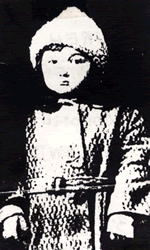
Sara Wechter was born in Kolomyja, Poland in 1927 to Esther and Yizhak Binyamin Wechter. Prior to WWII she lived in Kolomyja, Poland.
Sara was murdered in the Shoah.
This information is based on a report to Yad Vashem by her cousin Fran Hisler
Maier Berl Wechter was born in Kolomyja, Poland in 1926 to Esther and Yizhak Binyamin Wechter. Prior to WWII he lived in Kolomyja, Poland.
Maier was murdered in the Shoah.
This information is based on a Yad Vashem report by his cousin Fran.
We know that Yocheved, Pinchas , Edel, Isaac Wechter,, had two sisters Henia and Sarah (and their families) who perished in the holocaust
but we are unclear about the facts (Alexander and a relative of Henia's husband gave Yad Vashem reports of the family as perished in 1941 yet
Sara from talking to her mother Shulamit wechter said 1944 in a death march) I pasted some information here which makes it more likely that it was in 1941
"Between the two world wars, the Jewish community of B?l?i was a vibrant population of trade, industry and culture, Zionism and Yiddish, political parties and youth movements. B?l?i was the second largest populated city in Bessarabia, with the second largest number of Jewish inhabitants after Kishinev, and the economic center of the region. In the official 1930 census, B?l?i was listed as having 14,229 Jewish residents, about 60% of its total population.
"Following the Molotov-Ribbentrop Agreement, B?l?i was absorbed into the Soviet Union in the summer of 1940, coming under Soviet rule.
"On 22 June 1941, the Germans invaded the USSR. On 9 July, B?l?i was occupied by German and Romanian armies, and waves of abuse and murder began. At the end of July, the German units and Gestapo officers left the city in the hands of the Romanians. In September 1941 the last of the Jews of B?l?i– some 2,800 people – were expelled to the M?rcule?ti Camp, and the Jewish population of the city ceased to exist. In M?rcule?ti, many members of the community died, and the rest were deported to Transnistria." [29]
M?rcule?ti (Romanian pronunciation: [m?rku?le?t?]) is a city in Flore?ti District, in northern Moldova, with a population of 2,081 at the 2004 census. The city was once the site of a Jewish agricultural and mercantile colony until its destruction in the Holocaust.[3]
]To read about it in Hebrew get the book Markuleshty; Yad le-Moshava Yehudit be-Bessarabia
Editor: Leib Kuperstein, Meir Kotik
Published: Tel Aviv 1977, Markuleshty Society
( only some was translated) https://www.jewishgen.org/yizkor/Marculesti/Marculesti.html
In film and television[edit]
Filmmaker Matthew Mishory's 2015 documentary Absent was filmed in M?rcule?ti, the site of a horrible atrocity in 1941 in which all of the village's Jews were massacred by the Romanian army.[4] The film introduces the current residents of M?rcule?ti, some of who seem to be unaware (or unwilling to discuss) what happened.[5] Mishory's own grandparents lived in the village, escaping to Israel just before the start of the Holocaust. In an interview with Tablet, Mishory discussed the complex emotions of filming there: "The history of M?rcule?ti and the Holocaust pose impossible intellectual and theological questions. All I can say is that my feelings about what happened in M?rcule?ti are complicated. I remain a practicing Jew. And I also have serious doubts about human nature. I'm angry that people who live overlooking a killing field lie about their history. But I also have a lot of empathy for the current residents of the village and their difficult circumstances".[6] The film had its world premiere at the Astra Film Festival in Sibiu, Romania[7] and led to efforts to preserve M?rcule?ti's abandoned Jewish cemetery.
The Kishinev (now the city Chi?in?u) pogrom
In the late 19th century, especially due to growing anti-Semitic sentiment in the Russian Empire and better economic conditions in Moldova, many Jews chose to settle in Chi?in?u. By the year 1897, 46% of the population of Chi?in?u was Jewish, over 50,000 people.[15]
As part of the pogrom wave organized in the Russian Empire, a large anti-Semitic riot was organized in the town on 19–20 April 1903, which would later be known as the Kishinev pogrom. The rioting continued for three days, resulting in 47 Jews dead, 92 severely wounded, and 500 suffering minor injuries. In addition, several hundred houses and many businesses were plundered and destroyed.[16] Some sources say 49 people were killed.[17] The pogroms are largely believed to have been incited by anti-Jewish propaganda in the only official newspaper of the time, Bessarabetz (???????????). Mayor Schmidt disapproved of the incident and resigned later in 1903. The reactions to this incident included a petition to Tsar Nicholas II of Russia on behalf of the American people by US President Theodore Roosevelt in July 1903.[18]
On 22 August 1905 another violent event occurred: the police opened fire on an estimated 3,000 demonstrating agricultural workers. Only a few months later, 19–20 October 1905, a further protest occurred, helping to force the hand of Nicholas II in bringing about the October Manifesto. However, these demonstrations suddenly turned into another anti-Jewish pogrom, resulting in 19 deaths.[18]
--On 28 June 1940, as a direct result of the Molotov–Ribbentrop Pact, Bessarabia was annexed by the Soviet Union from Romania, and Chi?in?u became the capital of the newly created Moldavian Soviet Socialist Republic.
in June 1941, in order to recover Bessarabia, Romania entered World War II under the command of the German Wehrmacht, declaring war on the Soviet Union. In the chaos of the Second World War, Chi?in?u was severely affected. In June–July 1941 the city came under bombardment by Nazi air raids. However, the Romanian and newly Moldovan sources assign most of the responsibility for the damage to Soviet NKVD destruction battalions, that operated in Chi?in?u until 17 July 1941, when it was captured by Axis forces.[23]
During the German and Romanian military administration, the city suffered from the Nazi extermination policy of its Jewish inhabitants, who were transported on trucks to the outskirts of the city and then summarily shot in partially dug pits. The number of Jews murdered during the initial occupation of the city is estimated at approximately 10,000 people.[24] During this time, Chi?in?u, part of the L?pu?na County, was the capital of the newly established Bessarabia Governorate of Romania.[25]
"The Death Trap" – Transnistria
Transnistria was conquered by the Germans and Romanians in the summer of 1941. Before the war, some 300,000 Jews lived in the region. Tens of thousands were murdered by the Einsatzgruppen D, commanded by Otto Ohlendorf, as well as by German and Romanian soldiers. After the occupation, Transnistria became a concentration point for Jews from Bessarabia and Bukovina deported there at the command of Ion Antonescu. The few survivors of the mass murders in Bessarabia and northern Bukovina were mostly deported and concentrated in ghettos and camps in northern and central Transnistria. They were forbidden to travel or choose where to live, and were sent to forced labor.
We came to Obodovka… there we met Levis Zania and his wife, and many people from Kishinyevski Street, the wife of the lawyer Lifshitz, Mordechai Fod, Yasha Tzirlonik, Shimon Galanter and others… they "welcomed " us and pushed us into a stable instead of the animals where we suffered from the terrible cold… to this hell the wretched and miserable of Giurgiu, Romania, also arrived, among them Bori Feldman and his family, Lyoba and her sister… many of those in the stable died… life in Transnistria was a hell of torment and suffering.
Goldiak Wolf, Sefer B?l?i, p. 605
In her memoirs, Bella (Maims) Rot, born in B?l?i, describes Yom Kippur in the Scazinets Camp in Transnistria:
Throughout the camp, the silence of a graveyard and a stifling feeling prevailed… in the building were distorted people, some of them completely naked, some covered with rags… we entered the long, clean hall in which the stench of death also lingered… in the depths of the hall stood a holy ark made of four planks of wood… we sat down among the worshippers… women, men and older children, some of them so bloated we could not recognize them, almost dying… all shaking from cold and sickness… one of the women wished us all a chatima tova and announced that everybody was fasting that day. Suddenly, a tall desiccated male figure appeared, with the face of a skeleton. It was the shaliach tzibbur, the rabbi. The entire congregation gathered there prayed and cried with him.
Bella (Maims) Rot, Sefer B?l?i, pp. 609-610
The deportees organized themselves and tried to help each other survive. Their resources were few, and help from the Autonomous Refugee Aid Committee was delayed. At the beginning of January 1943, the first mission of the aid committee arrived in Transnistria, headed by Fred Shraga. The mission put together a report on the severe conditions of the Jews in Transnistria, and sent it to Jewish institutions in the US to recruit help.
In Dubina, the Jews were put into a large barn with broken doors and windows. They pushed 400 people into this room meant for animals. By the end, only 40 people remained alive. Every day they died like flies, from disease, hunger and cold. Romanian soldiers prevented them from going out to look for food.
Chana Luketsher Wroshavskia, Sefer B?l?i, p. 607
Towards the end of 1943, help began to arrive from the JDC, the Rescue Committee of the Jewish Agency in Turkey, the World Jewish Congress and "OSE." In April 1943, Antonescu agreed to return 5,000 orphans and other Jews that had been deported "by accident" to Romania, but the action was never carried out. In March 1944 the Red Army began to liberate Transnistria, and some 2,500 Jews were allowed to return to Romania.
In 1945-1946 most of the survivors were allowed to return to Romania.
Eilat Gordin Levitan
Isaac Meilijson: I’ll add painful support to Eilat’s description of the tragedy, as it affected my family Meilichson Risman. They lived in Yedenitz, quite north in Bessarabia. In parallel to the concentration in Marculesti, Jews of the northern part were concentrated by the Romanians for the Nazis in Vertujeni. on the Dniester. My grandmother Hanna Sara, uncles, cousins were murdered there in September 1941. I attach the invitation to the wedding of my parents in Santiago de Chile, February 1943. In the absence of information, my father writes his mother in the invitation, as inviting to her son’s wedding. My sister Blanca Judith was born in 1945 and my cousin Lilian in 1946. The next birth was of my cousin Reuven Hannan, named after our grandmother. In 1946 nothing had been heard yet! It was only when the cousin Joseph Risman of my father arrived to Israel around 1947, that he documented the family sad history and re-established contact with my father and his brothers in Chile and Argentina.
1944 is the date when the Wechter family received the letter with the terrible news of what happened in 1941.
isaac
